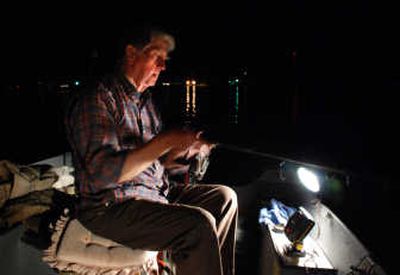Rich Landers: Hot weather no reason for anglers to be steamed

The term “hot fishing” isn’t cool this week.
City chicks and old men alike are wading into the region’s rivers without a squeal or hesitation, indicating the streams are like bathwater – too warm for the comfort of trout.
Anglers don’t need to take up bowling or other air-conditioned sports during a heat wave, but they may need to shift gears.
For example, forget the evening hatch on the Clark Fork River for a while.
Warm water temperatures have prompted fishing closures or restrictions on several prized Montana rivers. Montana law requires the closures when water temps reach 73 degrees to protect fish stressed to the point they can’t survive the rigors of catch-and-release.
Starting Friday, portions of the Clark Fork and Bitterroot will be closed to fishing from 2 p.m. to midnight.
The rule applies to 137 miles of the Clark Fork from the mouth of Rock Creek near Clinton to the confluence with the Flathead River, approximately 10 miles southeast of Plains.
The lower St. Joe River has a de facto closure on hot weekend afternoons owing to the steady parade of pleasure floaters cooling off in rafts and inner tubes. The bite last weekend had tapered by noon anyway, so I just went with the flow, taking a long break, giving the dogs a swim, savoring a long lunch and a cold beer and watching the parade go by.
The fly fishing picked up again around 7 and the fish were clearly responding to the hatches by 8.
Many lake fisheries, such as bass and panfish, are less affected by warming water, but that doesn’t mean the region’s lake anglers are unaffected by a heat wave.
Water skiers, jet skiers and pleasure boaters flock to the region’s lakes in the hot weather and keep the water churning through the heat of the day and well into the evening.
Peacefulness is part of fishing’s attraction, but you don’t find much of that during a hot summer day at, say, Loon Lake.
Even the period up to dusk can be loud and bumpy on the water now that a less-than-thoughtful crowd realizes there’s no longer a Stevens County marine patrol to enforce rules restricting night speed and light requirements for boats.
A few kokanee anglers, however, own the night at Loon Lake.
With a sonar flasher guiding him to the 31-foot depth in a hole across from his lake home, Red Crass eased his boat into position in the absolute still of darkness around 10 p.m. on Tuesday.
The day’s heat, noise and boat-rocking wakes were only a memory as he dropped anchor. His 5 1/2 -foot rod was already rigged with a half-ounce sliding bullet sinker above a snap swivel, 10 inches of leader and a phosphorescent Glo-Hook he charges with one of the four 20-watt lamps clamped to the side of the boat.
He baits the hook with three maggots, opens the bail on his spinning reel and lets the rig drop. When the line goes slack, he reels the line tight and then up one crank off the bottom.
Then he assumes the position.
“They call this the Loon Lake Stare,” he said, looking intently at the rod tip and very, very slowly raising the rod 2 feet or so before letting the rig drop.
Repeat, eyes never straying from the rod.
“I’ve seen good fishermen who had trouble sensing a kokanee’s bite,” he said. “It’s very subtle, sometimes just a slightly heavier feel on the rod as you lift it.”
Even Crass, who’s caught countless kokanee since he retired in 1989, misses the first few takes. To each tug at the end of the line, he jerks the limber rod skyward and pierces the quiet with a determined “Ugh!”
If it’s a miss, he drops the bait to the bottom again quickly and resumes the Loon Lake Stare as though he’s a robot that’s been reset to striking position.
Soon, he was into the fish, and they began coming into the boat as fast as he could reel up, drop the fish in a bucket, recharge the hook and drop the rig to the bottom.
It was almost startling to finally look up and see that two other boats had idled in within 100 feet and anchored so quietly they would have gone undetected except for the dim glow of low-wattage bulbs on their faces.
A 10-fish limit comes easily for Crass about the time it seems prudent to put on a sweater, savor the huge dark sky full of stars and head back to his dock, where the lights are out in virtually all of the shoreline homes.
This is a banner year to fish for Loon Lake kokanee, which are bigger than normal for this time of the season at 10-12 inches.
And with the heat on, this is the perfect week for enlightened anglers to be in the dark.